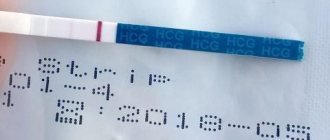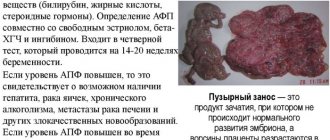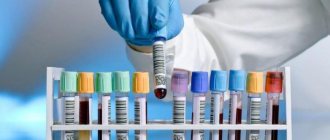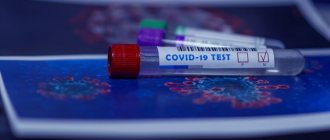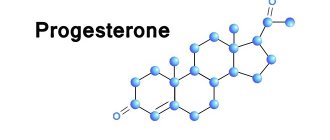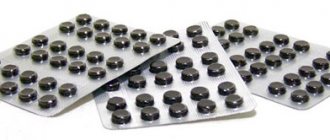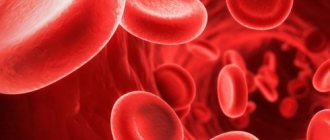The study of blood biochemistry includes such an indicator as ferritin - what is it and what does it mean? This is a protein molecule that ensures the preservation of iron in the body. The results of a blood test for ferritin determine the reserves of the macronutrient in the body. If ferritin is elevated, then there is a lot of iron; if it is low, the opposite is true.
Lack of iron in a pregnant woman leads to impaired fetal development and premature birth. When preparing for pregnancy, you need to study ferritin. Its deficiency leads to disruption of the formation of sex hormones. This becomes the cause of female infertility.
Increased levels of ferritin in the blood of women during pregnancy require additional examination. This may indicate a developing disease.
Ferritin structure and function
Iron ions are part of proteins that transport oxygen, iron seroproteins and cytochromes, iron-containing enzymes. Ferritin is a highly informative marker that characterizes iron metabolism. It is a water-soluble complex of iron hydroxyphosphate with the protein apoferritin. The largest amount of ferritin is found in the cells of the liver, spleen, bone marrow and reticulocytes, where the processes of production, maturation and degradation of red blood cells intensively take place. Ferritin is actively involved in the metabolism and redistribution of iron in the body.
The serum ferritin level allows us to estimate the total iron stores in the human body. In healthy people, the ferritin content in blood plasma is 20-350 ng/ml. Lack of iron in the body leads to negative consequences. The development of iron deficiency anemia is indicated by a drop in concentration below 10 ng/ml. Iron deficiency in the third trimester of pregnancy is found in almost 90% of women and persists after childbirth during breastfeeding in 55% of them.
With excessive accumulation of iron, ferritin concentration increases to several thousand ng/ml. Increased ferritin in the blood of women is the cause of toxicosis. You can take a blood test for ferritin at the Yusupov Hospital.
Rules for preparing for the test
The main goal of preparation is to minimize possible distortions in the analysis:
- Do not take iron supplements for a week.
- For 5 days, do not take penicillin and cephalosporin antibiotics, antifungal medications, hepatoprotectors that contain aluminum or silymarin.
- 3 days before the test, stop drinking alcohol; if the daily dose of alcohol in terms of ethanol exceeds 300 ml, do not test for ferritin for 7-10 days.
- Stop smoking one day before and eliminate red meat from your diet; liver, except chicken, 3 days in advance; Do not consume chicken liver the day before.
- Do not eat food 12 hours before.
- Do not drink liquid 1 hour before.
- Don't worry for half an hour.
Methods for determining ferritin
Determination of ferritin concentration is carried out using three types of analysis:
- Radioimmune;
- Immunoenzyme;
- Fluorescent.
The principle of radioimmunoassay is as follows: ferritin of the sample being determined reacts with antibodies that are immobilized on a solid-phase carrier, and then binds to antibodies labeled with iodine-125. Labeled antibodies that have not reacted with ferritin remain in solution and are removed. The radioactivity of the “labeled antibody + ferritin with immobilized antibody” complex is measured on a gamma counter. In this case, the measured radioactivity is proportional to the amount of ferritin in the test sample.
Most immunological research methods use the polyvalency of ferritin in its reaction with antibodies. They are based on the principle of two-center immunometric analysis. In this embodiment, each ferritin molecule binds two antigenic centers with two antibody molecules: with an antibody that contains a label (enzymatic, isotopic or fluorescent), and with an antibody that is attached to a polymer carrier. Most diagnostic tools use formed solid-phase carriers (balls, tubes, paper disks, stars) coated with antibodies as a separation system. Modern diagnostic kits use monoclonal antibodies.
Enzyme immunoassay methods for determining serum ferritin use special test systems. They are highly sensitive. Immunofluorescent methods are based on the detection of molecules labeled with a fluorescent label, which is characterized by a high ability to generate a signal. The most promising variant of the research method is considered to be one in which porphyrins or polymacrocyclic compounds are used as labels.
There are diagnostic test systems that are based on the principle of enhanced chemiluminescence. The rapid chemiluminescent ferritin assay measures ferritin in serum and plasma in a two-step, one-hour procedure.
Diagnosis of disorders
There are many reasons for changes in ferritin levels. To fix this, we first need to diagnose and diagnose correctly.
First of all, the doctor will collect the patient's medical history. With iron deficiency anemia, the typical symptoms a woman will name are weakness, increased fatigue, depression, pale skin
. Among the blood tests, the first to indicate a possible ferritin imbalance will be a complete blood count. It will indicate an insufficient number of red blood cells and hemoglobin for the complete and uninterrupted functioning of the body.
To confirm, the doctor prescribes another test that can calculate ferritin levels in the blood. Its reduced amount indicates long-standing anemia and the decompensatory stage.
To obtain results, blood must be taken from a vein on an empty stomach. Before the procedure, you are allowed to drink only still water.
Normal values and clinical significance of ferritin
In healthy adults, serum ferritin levels vary by gender and age. In men, the concentration of serum ferritin varies from 30 to 200 μg/L. In women of childbearing age, the concentration of ferritin in the blood serum is in the range of 10-90 mcg/l, in postmenopause it reaches average values that are typical for men. In children, serum ferritin levels increase sharply during the first three months of life. This is due to the rapid development of organs and tissues. Subsequently, from the age of six months until puberty, the level of ferritin in the blood serum remains unchanged, varying in the range of 34.4-4.1 μg/l.
What does ferritin show? Hematologists, by determining the level of ferritin in the blood, assess the iron reserves in the patient’s body. Serum ferritin is the earliest and most reliable sign of tissue iron deficiency. It precedes the development of iron deficiency anemia itself. With tissue iron deficiency and iron deficiency anemia, there is a decrease in ferritin in men below 30 mcg/l, in women and children below 10. When anemia is relieved and the iron depot is replenished, the level of serum ferritin is restored to normal. For this reason, hematologists at the Yusupov Hospital use it as a method of objectively assessing the adequacy of the treatment provided.
To obtain a reliable result of a ferritin test, the patient needs to prepare:
- Donate blood for testing on an empty stomach;
- Do not smoke 30 minutes before blood collection;
- On the eve of the study, avoid physical and psycho-emotional stress.
A high level of ferritin is observed in post-transfusion hemosiderosis and hemochromatosis (a hereditary disease characterized by increased absorption of iron from the digestive tract, increased deposition in tissues and organs). Scientists have found that ferritin also has other functions not directly related to iron metabolism. H-isoforms of ferritin play the role of suppressors in the proliferation of blood cells. They slow down the division of myeloid and lymphoid cells.
Ferritin levels increase during acquired immunodeficiency virus infection. The concentration of total ferritin also increases during an acute inflammatory process, which allows us to consider ferritin as an acute-phase protein.
Ferritin has cytoprotective properties. It is found in large quantities in pancreatic cells. It is used to retain zinc, which is abundant in insular cells. Zinc competes with iron for binding sites in ferritin and transferrin.
Ferritin is associated with tumor necrosis factor, which is released by certain cells as a result of the following stimuli:
- Viruses;
- Ultraviolet irradiation;
- Interleukins;
- Oxidative stress.
High ferritin in the blood is determined in malignant tumors of the ovaries, breast, and hepatocellular cancer. An increase in the concentration of serum ferritin in liver diseases is associated with the process of release of ferritin from liver cells during their destruction.
A significant increase in serum ferritin is observed in the following malignant neoplasms:
- Prostate cancer;
- Lymphogranulomatosis;
- Non-Hodgkin's lymphomas;
- Testicular cancer;
- Pancreatic cancer.
An increase in ferritin is observed in patients suffering from blood diseases: acute leukemia, chronic myeloid leukemia, acute erythromyelosis.
Norm of ferritin in the blood of women by age + table
Normally, ferritin levels in women are slightly lower than in men. Let's take a closer look at the normal values for patients of different ages.
| Age | Normal values, µg/l |
| Up to 15 years | 7 – 120 |
| From 15 | 10 – 125 |
Lower values of the indicator in women are due to the fact that their hemoglobin level is lower than in men. The concentration of iron and ferritin naturally decreases. This phenomenon is a variant of the physiological norm and does not require the selection of correction methods.
Methods for increasing and decreasing ferritin concentrations
Iron supplements that are used to increase ferritin levels in the blood are divided into the following groups:
- For oral and parenteral use;
- High-dose and low-dose;
- One-piece and combined.
Doctors at the Yusupov Hospital determine the route of administration of the drug depending on the specific clinical situation. Treatment of iron deficiency conditions is carried out mainly with iron preparations for oral administration. Iron preparations for parenteral administration are prescribed only for special indications: condition after extensive resection of the upper parts of the small intestine, impaired intestinal absorption syndrome. Experts from the World Health Organization recommend using the optimal daily dose of iron – 120 mg. Higher doses do not increase effectiveness, but may cause dyspeptic disorders due to irritation of the digestive tract.
Treatment with iron supplements is long-term. Normalization of ferritin levels occurs after 5-8 weeks of treatment. When choosing iron supplements, doctors also take into account their composition. The presence of ascorbic acid improves the absorption of iron ions in the intestine, prevents the transition from the divalent to the trivalent form, and accelerates the transport of iron. Vitamin B12 is necessary for the formation of red blood cells and hemoglobin. It takes part in the metabolism of fats, proteins, carbohydrates, and energy production.
Folic acid is the most important factor in preventing fetal abnormalities. It is necessary for the synthesis of DNA and RNA, protein metabolism and the production of red blood cells. Hematologists use drugs that contain all these components in the treatment of iron deficiency conditions. One of them is Ferro-Folgamma. If the level of ferritin in the blood is low, therapy is carried out with iron-containing drugs (ferlatum, maltofer, totema).
Reduces the level of ferritin in the blood by consuming foods rich in calcium, the excess of which impairs the absorption of iron, rice (promotes the removal of toxins and excess microelements from the body), and the removal of blood for transfusion. When ferritin levels are high, hepatoprotective drugs and zinc preparations are prescribed.
In order to take a blood test for iron and ferritin, call the contact center or make an appointment with a hematologist at the Yusupov Hospital online. The study is necessary if there are abnormalities in the general blood test associated with the number of red blood cells or hemoglobin level, if there are signs of iron deficiency (weakness, dizziness, cracks in the corners of the mouth) or excess iron (excessive fatigue, pain in the abdomen, joints, heart failure) in organism. A blood test for ferritin is also necessary for patients who are at risk of iron deficiency: pregnant women, young children, blood donors.
How to Replenish Serum Ferritin
The main reason for this deficiency is iron deficiency. That is why all ways to increase ferritin are based on replenishing the element.
Firstly, it is necessary to cure or put the disease into remission, be it gastritis or a bacterial infection. Secondly, a special diet with a high content of this element helps. The following foods are suitable:
| Sources of heme iron | Sources of non-heme iron |
|
|
Heme iron is contained in meat products and is more easily absorbed, unlike non-heme iron from plant foods. Such a diet is not able to restore the protein complex in the required quantity. The use of medications is mandatory.
Drugs are introduced into the body in two ways – orally (by mouth) and parenterally (by injection). In addition, they may contain divalent or trivalent iron. A medicine with a divalent atom is better absorbed by body tissues, so it is more preferable for use.
Common drugs:
| Active substance | Name, price | Mode of application |
| Iron (II) sulfate | Tardiferon 220-280 rub. | 80 mg twice daily during or before meals orally. |
| Polymaltose iron(III) hydroxide complex | Ferrum Lek 150-1600 rub. |
|
| Maltofer 290-700 rub. | 1-3 (100-300 mg) tablets per day orally during or immediately after meals. | |
| Iron (II) gluconate in combination with other substances | Totema 520-550 rub. | 2-4 ampoules (100-200 mg) per day orally, mixed with water. |
| Iron (II) sulfate + serine | Aktiferrin 250-270 rub. | 5 drops per 1 kg of body weight orally 2-3 times a day. |
| Iron (II) sulfate + ascorbic acid | Sorbifer Durules 400-550 rub. | 1 tablet twice a day with water, without chewing. |
| Iron protein succinylate | Ferlatum 1000-1100 rub. | 1 bottle (40 mg) 2 times a day orally. |
| Iron (III) hydroxide sucrose complex | Venofer 3000-3100 rub. | Individual dose calculation for parenteral administration. Before administration, a test dose with the introduction of 20 mg of iron. |
Serum ferritin is a valuable indicator for a doctor. Fluctuations in the level of this protein complex help to recognize not only anemia, but also tumor diseases of the blood system. You should not try to adjust its concentration on your own without identifying the cause: a wider range of therapeutic measures may be required.
Author:
Selezneva Valentina Anatolyevna physician-therapist
When the immune system goes crazy
It is already well known that COVID-19 is more severe in older people, in those who have diabetes, arterial hypertension, coronary heart disease and a number of other chronic diseases. Such patients are more likely to develop severe lung damage - acute respiratory distress syndrome. This is talked about so often today that many already know that the so-called cytokine storm plays a tragic role in this condition.
This is an excessive and erroneous reaction of our immune system, which is no longer so much a fight against infection as an aggression against the patient himself. Starting in the lungs, the process affects the entire body and often leads to death.
Why is this condition dangerous?
There are many reasons for increased indicators, so the consequences may be different.
An increased content of iron-containing protein leads to pathologies of the pancreas, heart and liver. Excess ferritin also affects the course of potentially dangerous processes. It promotes intensive vascular growth, which is good for tissue regeneration, but extremely bad for tumors, since they increase simultaneously with the proliferation of the vascular epithelium. In the presence of neoplasms, ferritin should be maintained at the lower limit of normal.
Excess iron aggravates all existing diseases and causes other disorders. Hyperferritinemia in the blood serum may indicate the development of cardiosclerosis. The structure of the heart muscle becomes denser and less elastic. Over time, this leads to disruption of its functioning. It is not without reason that it is believed that high ferritin always means premature aging.
Secret witness to dark deeds
So, scientists have discovered several markers that increase the risk of developing COVID-19 in such a tragic scenario. The one most often mentioned in this context is the so-called D-dimer. Its role was first revealed by Chinese doctors in Wuhan, publishing their research this month in The Lancet. They found that a significant increase in D-dimer concentration was a strong predictor of mortality. In their opinion, this indicator “may be an early and useful marker” and it must be determined in patients entering dangerous phases of the disease. This will help you start the right treatment earlier. Doctors from Holland and the USA who studied this problem are inclined to the same conclusions.
What is D-dimer? It is formed during the breakdown of fibrin, a fibrous protein that forms the basis of blood clots. An increase in the concentration of D-dimer indicates that blood clots are forming in the body. They have not yet blocked the blood flow, caused a heart attack or stroke, or clogged small vessels, paralyzing their blood supply (by the way, all these processes are often the direct cause of death during coronavirus infection), but the process has already begun. D-dimer is a witness to the fact that these dangerous changes in the patient’s body are already occurring. The sooner you start fighting them, the better the treatment result will be.
How to increase, how to treat?
The reader may have noticed that ferritin testing is often used for differential diagnosis of various pathological conditions, which, of course, entails a differential approach to their treatment. Answering the question of how to increase ferritin, I would like to go back and remember what kind of substance this is and what its biological significance is, and, based on this, decide what measures should be taken if ferritin levels are low. You can increase it in the same way as increasing the iron content in the blood, that is, by consuming it with food. However, will there be any point in promoting yourself if you don’t know:
- What is the fate of the element (Fe) entering the body?
- Can it be safely absorbed in the intestines and delivered to tissues?
- Are there other disorders in the body that provoke a drop in ferritin concentration?
Such questions are most likely within the competence of the doctor, who, if necessary, prescribes a drug with a similar name - Ferritin. Or the iron-containing drug “Cosmofer”, intended for intravenous and intramuscular administration.
IDA treatment regimen
These drugs are used under laboratory control, because, unlike iron, which comes from food and cannot lead to an excess of the element in the body, synthetic ferritin in capsules or in solution can accumulate and create an excess supply, which can lead to side effects. Without proper laboratory monitoring at home and not having sufficient knowledge regarding all the movements of iron in the body, it is better not to try to do it on your own and not to turn iron-containing preparations into a medicine intended for the home medicine cabinet, like analgesics, antispasmodics, antipyretics.
Iron supplements are not at all cheap, they have a lot of restrictions and contraindications; if used thoughtlessly, they can lead, at best, to overaccumulation of the element in the liver with the development of an inflammatory process, and at worst, cause not only allergic reactions, but also anaphylactic shock. Among other things, the patient, when starting treatment, must be absolutely sure that he has iron deficiency anemia, and not some other form where ferritin may be superfluous. It is unlikely that, having gleaned some information, even from reliable sources, a person who does not fully understand the issue will be able to thoroughly understand everything, so self-medication may turn out to be not only inappropriate, but in some cases harmful. It’s worth thinking about, because everyone should mind their own business...
Iron marker
Another marker that may indicate more severe COVID-19 is related to iron. This is the protein ferritin. It binds excess iron and thus plays a positive role.
On the other hand, iron is toxic; it is aggressive to tissues. This is how this element acts if it is not part of hemoglobin and some enzymes. To weaken the negative effect of such free iron, ferritin binds it. But when there is a lot of this protein, it can activate macrophages. These cells play a major role in the functioning of the immune system. And, unfortunately, during coronavirus infection they can be actively involved in the process of cytokine storm.
Complexes with this research
Vegetarians and vegans Control of metabolism when refusing animal products RUR 3,800 Composition
Anti-aging diagnostics in postmenopause Control of age-related changes during postmenopause RUR 8,130 Composition
Blue blood Assessment of iron deficiency and the efficiency of the iron metabolism mechanism 2 180 R Composition
IN OTHER COMPLEXES
- Advanced anti-aging diagnostics in postmenopause RUR 20,600
- Male anti-aging diagnostics RUB 8,620
- Women's anti-aging diagnostics RUB 7,760
- Advanced women's anti-aging diagnostics RUB 20,230
- Advanced male anti-aging diagnostics RUB 23,630
Increased ferritin levels in coronavirus
This indicator does not apply to a general blood test , but today it is key.
COVID-19 damages the hemoglobin gene, causing the iron atom to become blocked. Because of this, excess iron is formed in the body, which interferes with the exchange of oxygen and leads to hypoxic syndrome (oxygen starvation)
The development of this dangerous life-threatening complication can be predicted by an increase in the level of ferritin (a protein that is produced in the liver and collects all the iron that is in the body). Excess ferritin provokes a “cytokine storm,” an overreaction of the immune system in which an excessive number of immune cells are produced. “Cytokine storm” leads to a sudden deterioration of the condition, which often causes sudden death in patients who previously had a mild disease
When should you get tested?
It is advisable to conduct a study when deviations from the reference values of a clinical blood test are detected. For example, with an increase or decrease in hemoglobin and red blood cell levels.
A test must be taken if the patient has symptoms of iron excess or deficiency. Symptoms indicating a decrease in iron concentration: fatigue, drowsiness, lack of appetite, depressive disorders, muscle weakness, pallor, yellow or bluish sclera, frequent headaches and shortness of breath, hair loss and brittle nails, dry skin. The patient has strange taste preferences, for example, a desire to eat chalk or clay. The analysis is also relevant when assessing the effectiveness of the chosen treatment regimen.
Diseases with elevated ferritin
The most common causes of elevated ferritin levels are obesity , inflammation , and daily alcohol intake . The most common cause of genetically determined elevated ferritin levels is the condition of hemochromatosis. Additional causes include diabetes mellitus and metabolic syndrome. (5, 6)
Circulating ferritin in the blood is recognized as an acute phase reactant and a marker of severe and chronic inflammation. It is elevated in a significant number of inflammatory conditions, including chronic kidney disease, rheumatoid arthritis and other autoimmune diseases, acute infections, and malignancies. (2)
Elevated ferritin in these conditions reflects increased total body iron stores, but paradoxically these stores are reduced and are not available for red blood cell production. This contributes to the development of anemia of chronic disease (ACD). (2)
It should be noted that although ferritin levels generally increase during infections, some infectious diseases can lead to a decrease in ferritin.
Diseases in which ferritin levels increase:
- Inflammation
- Chronic kidney disease
- Rheumatoid arthritis
- Autoimmune diseases
- Infections
- Cancer
- Anemia of chronic disease ACD
- Diabetes mellitus type 2
- Metabolic syndrome
- Atherosclerosis
- Fatty liver disease
- Anorexia
- Graves' disease
- Arrhythmias
- Hepatitis C
- Hemochromatosis
- Hemophagocytic syndrome
- Sideroblastic anemia
Hemochromatosis
Ferritin is used as an indicator of iron overload in the body in diseases such as hemochromatosis or hemosiderosis. Hemochromatosis is a disorder in which too much iron accumulates in your body.
Typically, your intestines absorb only the right amount of iron from the foods you eat. But with hemochromatosis, your body absorbs too much iron and has no way to get rid of it. Thus, the body begins to store excess iron in the joints and organs such as the liver, heart and pancreas. This harms the body. If left untreated, hemochromatosis can lead to organ failure.
However, a number of other health conditions can also cause iron levels to rise:
- Hyperthyroidism
- Iron poisoning
- Cancer: leukemia, lymphoma or breast cancer
- Liver disease
- Recent blood transfusion
Alcohol intake
Alcohol enhances iron absorption . Alcohol consumption is very strongly associated with high ferritin levels. A positive relationship was found between wine intake and the concentrations of both ferritin and iron in the blood.
Ferritin levels increase during alcohol abuse and decrease rapidly during alcohol withdrawal syndrome when alcohol is stopped.
Smoking
Women who smoke have higher levels of ferritin and iron in their bodies compared to non-smokers. However, when women smoke during pregnancy, their newborn babies show lower iron stores than those of non-smoking mothers. (17)
Tobacco smoking was associated with elevated ferritin concentrations in patients with Parkinson's disease (under these conditions, smoking had a beneficial effect in these patients).
Ferritin is low - what does it mean, symptoms
If ferritin is low, this means that iron reserves in the internal organs are low. The symptoms reflect precisely the general lack of microelement:
- chronic fatigue;
- general weakness;
- fatigue with little physical activity;
- dizziness;
- frequent headaches;
- Difficulty concentrating and remembering information.
If a decrease in ferritin occurs at an early stage of iron deficiency, then the patient may not have all these signs, but tests reveal a drop in hemoglobin, red blood cells, hematocrit, and an increase in ESR. In pregnant women in the blood (especially in the later stages), reduced ferritin refers to a physiological (non-disease) condition. With normal iron in the blood, it does not require correction.
Ways to reduce ferritin
It is important to discuss the situation with your doctor if the test shows elevated ferritin. Your doctor should identify the cause of the elevated ferritin and prescribe treatment.
You may also try the additional actions listed below if you have discussed them and agreed with your doctor, provided that such actions may be appropriate for reducing ferritin levels in your case. Remember that none of the additional options for lowering ferritin should be used instead of the recommendations and prescriptions of a doctor.
Danger of deviation from the norm
Dangers of low ferritin:
- Fall in blood pressure – weakness – fainting.
- Kidney failure, fragility of blood vessels.
- Hardening, loss of elasticity of bone tissue.
- Uncontrolled muscle contractions.
- Decreased immunity – increased likelihood of an infectious disease; lack of reaction to viruses and bacteria that have entered the body.
- Dehydration of the body.
- Impaired intestinal motility.
- Blood thinning.
The dangers of elevated ferritin:
- Creating a favorable environment for the development of cancer cells.
- Reducing the life of cells - accelerating the process of division and premature wear and tear of the body.
- Tendency to arthritis, rheumatism and other collagen diseases.
- Heart attacks, strokes due to fragility of blood vessels.
- Thickening of the blood - the formation of blood clots.
- Formation of cholesterol plaques; sclerosis, atherosclerosis.
- Damage to soft tissues – 400 and above or above 250 for more than six months.
- High tendency to suppuration.
The likelihood of tumors, regardless of benignity, increases with both excess and deficiency of ferritin. In the first case, due to the high rate of oxidative reactions; in the second - lack of fluid in the tissues. Elevated ferritin leads to sepsis, and decreased ferritin leads to necrosis.
If ferritin is elevated during necrosis, necrosis is the cause of its increase, and not vice versa. During menopause, it is necessary to monitor the ratio of ferritin and estrogen levels: high estrogen with low ferritin, or vice versa - adjust the hormone level. If estrogen is normal, adjust ferritin.
Iron arguments
— It is important to predict the development of complications. But how to prevent them from developing?
— There are very few drugs and procedures in the world that remove excess iron from the body. There is a registered drug in Russia (hepaprotector and immunostimulant) that could be useful. As Japanese and domestic observations show, it reduces ferritin levels in patients with liver disease and congenital hemochromatosis (a hereditary disease in which iron is deposited in the body, which leads to organ damage). Scientists who have worked with it believe that it may also be effective in severely ill patients with COVID-19.
Pneumosclerosis is a legacy of COVID-19. What will happen to the lungs after coronavirus? More details
— Now they are trying to treat coronavirus infection with antimalarial drugs that do not have a specific effect...
“The drugs that were donated by our Chinese colleagues as humanitarian aid help transport oxygen in the body. This medicine, under the same international nonproprietary name, has long been used in Russia for diseases of the musculoskeletal system. Due to the lack of an alternative at the beginning of the pandemic, it was recommended to patients with coronavirus infection to prevent oxygen starvation. Its effectiveness is still being debated. For example, French studies show that it is insufficient.
— How justified is the use of unregistered drugs? For example, in Brazil, 11 patients died during clinical trials of a Chinese drug.
— The causes of death of these patients are not known for certain. I am convinced that the data of our Chinese colleagues can be trusted - they have the most experience in removing the population from dangerous situations that may arise in the outbreak of the disease, and they generously share it.
The pace of the epidemic and the number of cases do not allow time for reflection. That is why they are now trying to use means from the existing arsenal, the safety of which has already been proven.
A promising direction is the use of blood plasma from patients who have suffered from coronavirus. I believe that antibodies can be isolated from it, which in the future will serve as the basis for the creation of specific drugs.
In a state of siege. Where is the mildest quarantine regime in Russia? More details
— One famous virologist believes that quarantine prevents the development of collective immunity. After all, asymptomatic carriers are a live vaccine against coronavirus, and all of them are now in self-isolation.
— To develop collective immunity, it is necessary for ¾ of the population to get sick. It's unavoidable. Everyone will acquire immunity to coronavirus sooner or later. Asymptomatic carriers and vaccinating the population can actually speed up this process.
But at the same time, two scenarios for the development of the epidemic are possible. In the first case (without restrictive measures), the incidence curve has a short rise, a high peak and a rapid decline. In the second case (with the introduction of quarantine) there is a slow rise, a long plateau and a long descent. The area under both curves (the number of cases) is the same in both the first and second scenarios, but the percentage of deaths during quarantine is much lower.
Without restrictive measures, the “Italian variant” (a large number of sick people at the same time) is inevitable. In such cases, doctors have to choose who to save. Quarantine allows us to avoid such a situation and guarantee medical care for the majority of the population.
How and why to get tested
Patients are tested to determine ferritin levels only in the laboratory. No special preparation is required for this. The material for research is taken in the morning; you cannot eat before that. In order for the results to be as accurate as possible, the test tube must be clean and dry, otherwise it will not be possible to find out anything.
Indications for prescribing laboratory tests:
- If hemoglobin has not yet reached reduced levels, hidden iron deficiency can be identified.
- If you have been diagnosed with kidney failure. In this way, iron reserves can be monitored.
- If treatment has already been prescribed, then in this way you can check how effective it is. Taking iron supplements should produce normal results within five days. If tests show that nothing has changed, then the drugs are not effective and should be replaced with others.
- The analysis is needed to separate chronic anemia from anemia, which simply does not have enough iron.
If the development of malignant tumors is suspected, a tumor marker will be used. If a large amount of iron is detected, additional tests will be ordered.
Changes in general blood test parameters during infection with coronavirus COVID-2019.
CORONAVIRUS is a causative agent of ARVI, which causes severe intoxication of the body and problems with the respiratory and digestive systems.
The virus is transmitted:
- Airborne droplets from sneezing and coughing
- By contact
Symptoms of coronavirus
- Increased fatigue
- Feeling of heaviness in the chest
- Fever, chills (43.8% on admission and 88.7% on hospitalization)
- Nasal congestion
- Sneeze
- Cough (67.8%)
- A sore throat
- Muscle pain
- Pallor
- Rarely diarrhea (3.8%)
Complications from coronavirus
- Otitis
- Sinusitis
- Sepsis
- Gastrointestinal problems (in children)
- Bronchitis
- Pneumonia
- Myocarditis (inflammation of the heart muscle)
Sometimes the disease occurs without symptoms (often in children). Body temperature may be normal, and many do not have abnormal changes on X-ray of the lungs.
In a general blood test with leukocyte formula, the following changes are observed:
- Lymphocytopenia (lymphopenia) 83.2% of patients
- Thrombocytopenia 36.2% of patients
- Leukopenia 33.7% of patients
Lymphocytopenia due to coronavirus
Lymphocytopenia is a decrease in the number of lymphocytes in absolute values with a general blood test below 1.0 thousand/μl. Some doctors believe that lymphocytopenia occurs when the lymphocyte count is below 1.5 * 109/l
Thrombocytopenia due to coronavirus
Thrombocytopenia is a condition characterized by a decrease in platelet count below 150*109/l, which is accompanied by increased bleeding and problems stopping bleeding.
Symptoms
Symptoms of low ferritin:
- weakness;
- dizziness;
- tachycardia;
- aching muscle pain without physical activity;
- dyspnea;
- increased sweating;
- pale skin;
- apathy;
- diarrhea;
- hair loss;
- peeling of nails;
- chest pain;
- itching
Symptoms of elevated ferritin:
- decreased sex drive;
- pain in bones, joints;
- weight loss;
- characteristic ferrous taste in the mouth;
- constipation;
- swelling of the face is possible;
- frequent palpable pulsation of blood vessels.
Irritability, muscle spasms, and nosebleeds are symptoms of both high and low ferritin levels. Bleeding can occur both due to thin blood and fragility of blood vessels with low ferritin, and due to thin walls of blood vessels and high pressure with increased ferritin.
With low Fe, contractility and muscle volume decrease, and with increased Fe, muscle hypertension and an increase in muscle protein myofibril molecules occur. Brain cells with low amounts of iron replenish the metal component with calcium.
With low ferritin, short-term irritability alternates with long-term apathy, and with elevated ferritin, long-term irritation may not alternate with melancholy.
Additional examinations
Supportive measures are aimed at discovering the initial mechanism of development of the disorder. This is much more important than stating a fact. That is, at this stage, doctors are looking for an etiological factor. The reason. The work is carried out by a hematology specialist.
Among the events:
- Oral questioning of the patient. To identify all violations.
- Anamnesis collection. Second important point. Allows us to assume the origin of the pathological condition.
- Ultrasound of the liver and digestive tract as a whole.
- Scintigraphy.
- Blood tests for hormones. Doctors are mainly interested in thyroid conditions.
- MRI and CT as needed. If there is a real risk of cancer or the cancer process in general.
- Blood test for inflammatory factors. Infectious or autoimmune.
The list is incomplete. In reality there are much more events. It all depends on the patient’s health condition and the doctor’s assumption.
A ferritin test provides a lot of information. But it's not enough. A team of tests is required to make an accurate diagnosis. A hematologist assesses a person’s condition.
Reasons for the increase
The changes are due to several factors.
- Cancer. It doesn't matter what localization. At the initial stage, ferritin concentration increases. Then it begins to decline rapidly. Changes are especially often observed in pathologies of the mammary gland, intestines, and oncological pathologies of the digestive tract.
- Infectious inflammations. More iron is required, so the body absorbs it in significant quantities. The phenomenon is temporary. But quite indicative for doctors.
- The same applies to autoimmune pathological processes. All inflammation provokes changes in ferritin concentration towards its increase.
- Hepatitis. Infectious liver disease. It is caused by several types of viruses. Regardless of the strain, the concentration of the substance at the initial stage of the disease is excessive. This is a compensatory reaction of the body.
- Blood transfusions. The artificial introduction of additional iron has an effect. The change is especially noticeable with frequent use of donor connective tissue. For example, after injuries or surgical treatment.
- Cirrhosis of the liver. Acute or chronic tissue death of the largest gland. Accompanied by severe changes in structures and the development of bleeding. At the initial stage, ferritin increases due to increased absorption of the substance.
- Leukemia.
What can give false results
The ferritin test is carried out according to certain rules. They need to be considered in the context of possible imaginary outcomes. That is, those that do not reflect the real state of affairs.
What exactly can affect the diagnostic results:
- Starvation. Since the body does not receive enough iron from food, the substance is released from ferritin molecules. This happens gradually. However, a few days of a strict diet is enough to artificially reduce the levels of the substance. This result will be false. It is necessary to adjust the diet, but not reduce its calorie content. Because otherwise there will be no sense in diagnostics.
- Taking certain medications. The group of medications is quite extensive. This includes medications such as hormonal contraceptives, iron-based medications, and some antibiotics.
Also among the dangerous drugs are estrogens. They need to be abandoned. For a while until the examination is completed. It is better to check the timing with your doctor. You cannot stop taking medications without permission, only at the discretion of a specialist.
- Alcohol has an equally negative effect. Therefore, the day before the examination, you should not drink a drop of alcohol. The accuracy of the diagnosis depends on this.
- Recent radioisotope study. Since the medications that are used can provoke an increase in ferritin concentration. These are false results that do not reflect reality. You need to wait at least 3-4 days.
- Intense physical activity on the eve of diagnosis. Mechanical activity is avoided for several days. This does not mean that you need to sit in one place and be afraid to move. Just don't overdo it. No sports.
There are not many factors. However, the preparation rules must be strictly followed. In order not to provoke false results. The quality of future treatment depends on this. If you need it at all.
